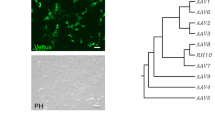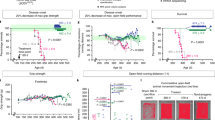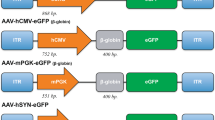Abstract
Adeno-associated viral (AAV) vectors are often used in gene therapy for neurological disorders because of its safety profile and promising results in clinical trials. One challenge to AAV gene therapy is effective transduction of large numbers of the appropriate cell type, which can be overcome by modulating the viral capsid through DNA shuffling. Our previous study demonstrates that Rec2, among a family of novel engineered hybrid capsid serotypes (Rec1~4) transduces adipose tissue with far superior efficiency than naturally occurring AAV serotypes. Here we assessed the transduction of adult spinal cord at two different doses of AAV vectors expressing green fluorescent protein (2 × 109 or 4 × 108 viral particles) via intraparenchymal injection at the thoracic vertebral level T9. In comparison with an equal dose of the currently preferable AAV9 serotype, Rec3 serotype transduced a broader region of the spinal cord up to ~1.5 cm longitudinally and displayed higher transgene expression and increased maximal transduction rates of astrocytes at either dose and neurons at the lower dose. These novel engineered hybrid vectors could provide powerful tools at lower production costs to manipulate gene expression in the spinal cord for mechanistic studies or provide potent vehicles for gene therapy delivery, such as neurotrophins, to the spinal cord.
This is a preview of subscription content, access via your institution
Access options
Subscribe to this journal
Receive 12 print issues and online access
$259.00 per year
only $21.58 per issue
Buy this article
- Purchase on Springer Link
- Instant access to full article PDF
Prices may be subject to local taxes which are calculated during checkout








Similar content being viewed by others
References
Kotterman MA, Schaffer DV . Engineering adeno-associated viruses for clinical gene therapy. Nat Rev Genet 2014; 15: 445–451.
Mingozzi F, High KA . Therapeutic in vivo gene transfer for genetic disease using AAV: progress and challenges. Nat Rev Genet 2011; 12: 341–355.
Asokan A, Schaffer DV, Samulski RJ . The AAV vector toolkit: poised at the clinical crossroads. Mol Ther 2012; 20: 699–708.
Charbel Issa P, De Silva SR, Lipinski DM, Singh MS, Mouravlev A, You Q et al. Assessment of tropism and effectiveness of new primate-derived hybrid recombinant AAV serotypes in the mouse and primate retina. PLoS ONE 2013; 8: e60361.
Mizukami H, Mimuro J, Ogura T, Okada T, Urabe M, Kume A et al. Adipose tissue as a novel target for in vivo gene transfer by adeno-associated viral vectors. Hum Gene Ther 2006; 17: 921–928.
Zhang FL, Jia SQ, Zheng SP, Ding W . Celastrol enhances AAV1-mediated gene expression in mice adipose tissues. Gene Therapy 2011; 18: 128–134.
Jimenez V, Munoz S, Casana E, Mallol C, Elias I, Jambrina C et al. In vivo adeno-associated viral vector-mediated genetic engineering of white and brown adipose tissue in adult mice. Diabetes 2013; 62: 4012–4022.
Liu X, Magee D, Wang C, McMurphy T, Slater A, During M et al. Adipose tissue insulin receptor knockdown via a new primate-derived hybrid recombinant AAV serotype. Mol Ther Methods Clin Dev 2014; 1: 8.
Foust KD, Nurre E, Montgomery CL, Hernandez A, Chan CM, Kaspar BK . Intravascular AAV9 preferentially targets neonatal neurons and adult astrocytes. Nat Biotechnol 2009; 27: 59–65.
Snyder BR, Gray SJ, Quach ET, Huang JW, Leung CH, Samulski RJ et al. Comparison of adeno-associated viral vector serotypes for spinal cord and motor neuron gene delivery. Hum Gene Ther 2011; 22: 1129–1135.
Foust KD, Wang X, McGovern VL, Braun L, Bevan AK, Haidet AM et al. Rescue of the spinal muscular atrophy phenotype in a mouse model by early postnatal delivery of SMN. Nat Biotechnol 2010; 28: 271–274.
Gray SJ, Matagne V, Bachaboina L, Yadav S, Ojeda SR, Samulski RJ . Preclinical differences of intravascular AAV9 delivery to neurons and glia: a comparative study of adult mice and nonhuman primates. Mol Ther 2011; 19: 1058–1069.
Dayton RD, Wang DB, Klein RL . The advent of AAV9 expands applications for brain and spinal cord gene delivery. Expert Opin Biol Ther 2012; 12: 757–766.
Burger C, Gorbatyuk OS, Velardo MJ, Peden CS, Williams P, Zolotukhin S et al. Recombinant AAV viral vectors pseudotyped with viral capsids from serotypes 1, 2, and 5 display differential efficiency and cell tropism after delivery to different regions of the central nervous system. Mol Ther 2004; 10: 302–317.
Huang W, McMurphy T, Liu X, Wang C, Cao L . Genetic manipulation of brown fat via oral administration of an engineered recombinant adeno-associated viral serotype vector. Mol Ther 2016; 24: 1062–1069.
Guo Y, Wang D, Qiao T, Yang C, Su Q, Gao G et al. A single injection of recombinant adeno-associated virus into the lumbar cistern delivers transgene expression throughout the whole spinal cord. Mol Neurobiol 2015; 53: 3235–3248.
Wang H, Yang B, Qiu L, Yang C, Kramer J, Su Q et al. Widespread spinal cord transduction by intrathecal injection of rAAV delivers efficacious RNAi therapy for amyotrophic lateral sclerosis. Hum Mol Genet 2014; 23: 668–681.
Hordeaux J, Dubreil L, Deniaud J, Iacobelli F, Moreau S, Ledevin M et al. Efficient central nervous system AAVrh10-mediated intrathecal gene transfer in adult and neonate rats. Gene Ther 2015; 22: 316–324.
Schuster DJ, Dykstra JA, Riedl MS, Kitto KF, Belur LR, McIvor RS et al. Biodistribution of adeno-associated virus serotype 9 (AAV9) vector after intrathecal and intravenous delivery in mouse. Front Neuroanat 2014; 8: 42.
Duque S, Joussemet B, Riviere C, Marais T, Dubreil L, Douar AM et al. Intravenous administration of self-complementary AAV9 enables transgene delivery to adult motor neurons. Mol Ther 2009; 17: 1187–1196.
Yang B, Li S, Wang H, Guo Y, Gessler DJ, Cao C et al. Global CNS transduction of adult mice by intravenously delivered rAAVrh.8 and rAAVrh.10 and nonhuman primates by rAAVrh.10. Mol Ther 2014; 22: 1299–1309.
Valori CF, Ning K, Wyles M, Mead RJ, Grierson AJ, Shaw PJ et al. Systemic delivery of scAAV9 expressing SMN prolongs survival in a model of spinal muscular atrophy. Sci Transl Med 2010; 2 35ra42.
Meyer K, Ferraiuolo L, Schmelzer L, Braun L, McGovern V, Likhite S et al. Improving single injection CSF delivery of AAV9-mediated gene therapy for SMA: a dose-response study in mice and nonhuman primates. Mol Ther 2015; 23: 477–487.
Acknowledgements
This work was supported by NIH grants CA163640, CA166590 and AG041250 (to L Cao), and P30 NS045758 (to The Ohio State Neuroscience Center Injury and Behavior Core).
Author information
Authors and Affiliations
Corresponding author
Ethics declarations
Competing interests
The authors declare no conflict of interest.
Rights and permissions
About this article
Cite this article
Siu, J., Queen, N., Huang, W. et al. Improved gene delivery to adult mouse spinal cord through the use of engineered hybrid adeno-associated viral serotypes. Gene Ther 24, 361–369 (2017). https://doi.org/10.1038/gt.2017.27
Received:
Revised:
Accepted:
Published:
Issue Date:
DOI: https://doi.org/10.1038/gt.2017.27
This article is cited by
-
Viral strategies for targeting spinal neuronal subtypes in adult wild-type rodents
Scientific Reports (2022)
-
Astrocyte-selective AAV gene therapy through the endogenous GFAP promoter results in robust transduction in the rat spinal cord following injury
Gene Therapy (2019)
-
The adeno-associated virus rh10 vector is an effective gene transfer system for chronic spinal cord injury
Scientific Reports (2019)
-
Intracellular generation of single-strand template increases the knock-in efficiency by combining CRISPR/Cas9 with AAV
Molecular Genetics and Genomics (2018)



